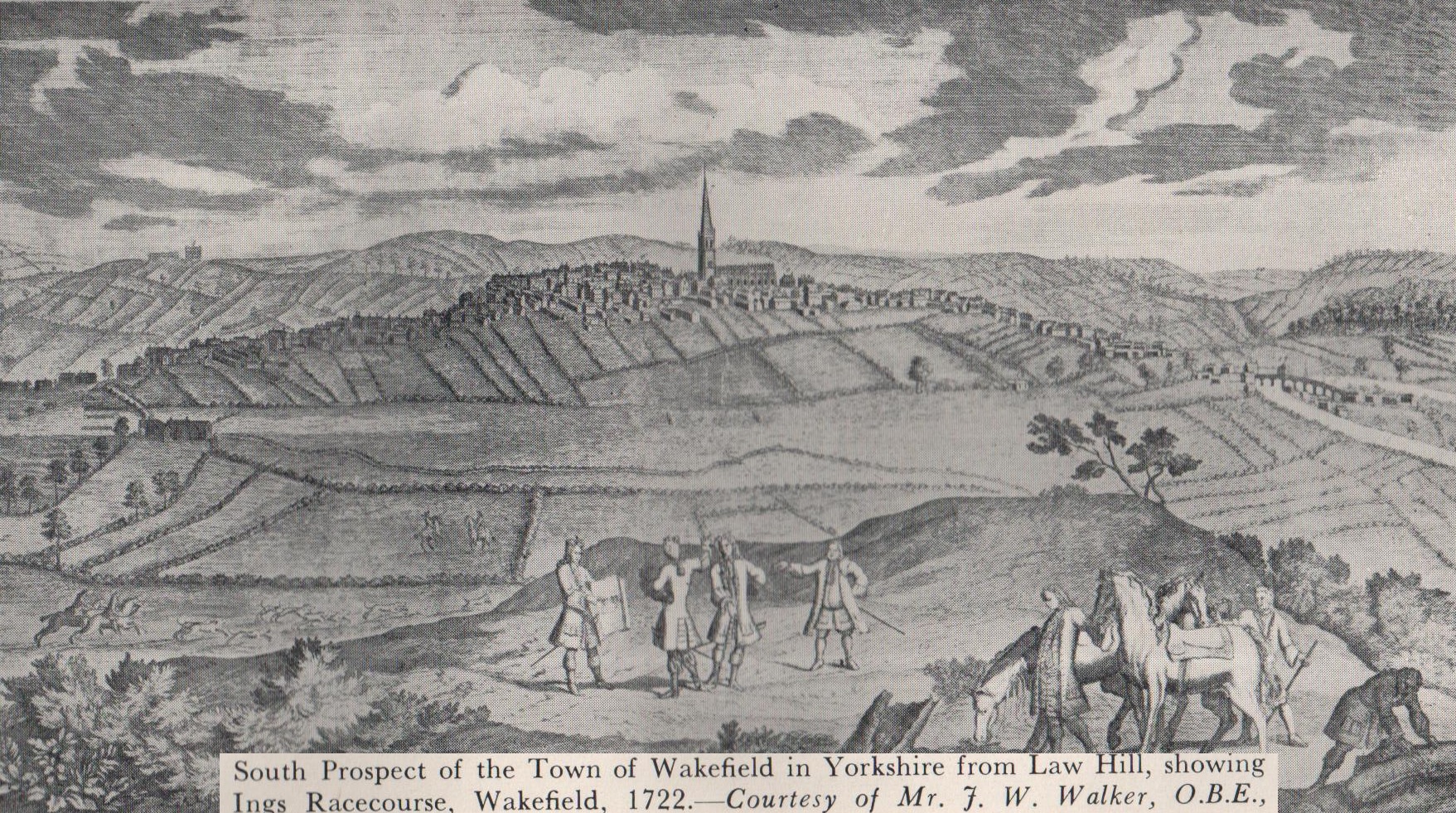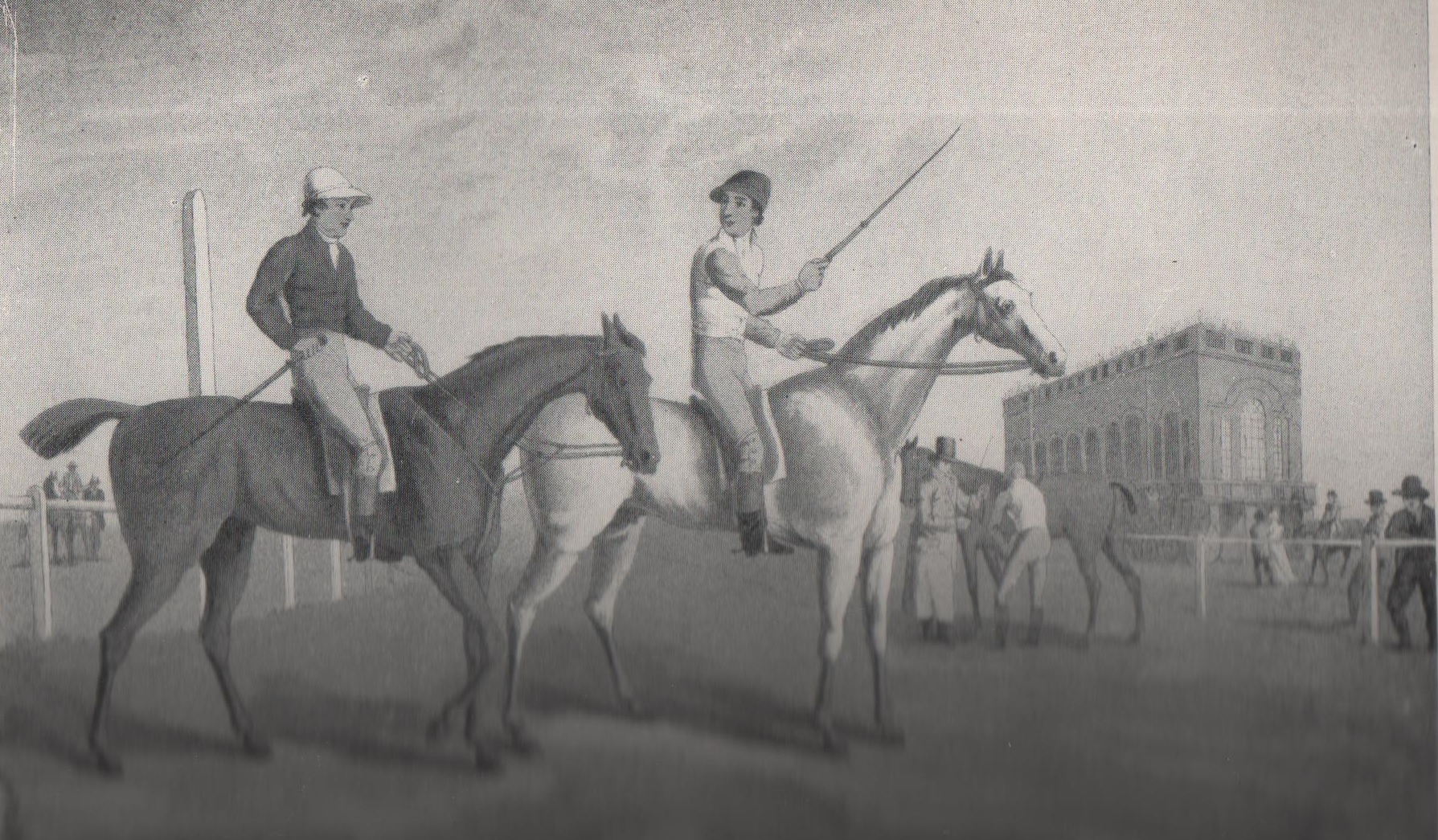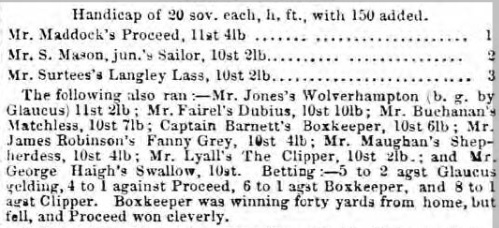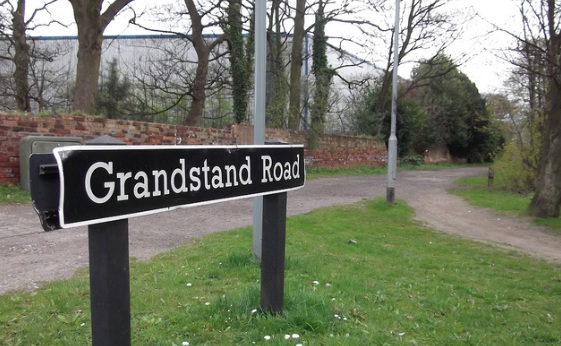Earliest meeting: Wednesday 21st August 1678
Final meeting: Wednesday 21st February 1849
The first evidence of racing at Wakefeld was in 1678 on the third Wednesday in August. It took place on The Ings near to Law Hill. However, once gentlemen landowners laid claim to The Ings the racecourse was relocated to Outwood, a course of about 2 miles round. It became established and a grandstand was built in 1745 financed by subscriptions from supporters who were given life membership badges, but racing only lasted at The Outwoods until 1794. There was a lull in organised meetings until 1847 when the Wakefield Grand National was launched by the Earl of Strathmore. It was contested over a 4 mile course, consisting of 53 fences, starting at Sandal Castle, but lasted for just 2 more years, with the final meeting on Wednesday 21st February 1849.
Earl of Strathmore, Lord Effingham, Sir G Armytage, Honourable J S Barry
Wednesday 21st August 1678
The London Gazette of 11th and 15th July 1678 ran an advert broadcasting Wakefield Races and outlining the specific details of the races. This was the earliest evidence of races being staged in Wakefield. The article read, 'These are to give notice that upon a heath within a mile of Wakefield in Yorkshire upon the third Wednesday in August next, and so on the same day every year, will be two plates run for, the first worth £30, for which any horse, or gelding, or mare may run, carrying 12st. The second, worth £15, for which no stoned horse is to run, nor any gelding or mare that will not be sold for £20 before he run. Each event to be run in three heats over 3 miles.'
Wednesday 20th August 1679
A similar article to the one published the previous year was included in the London Gazette in 1679. However, the article also specified that all horses intended to run shall be presented at the Market Cross in Wakefield on Monday, seven nights before the race day, between the hours of 10am and 2pm.
Wednesday 18th August 1680
It is known that racing was staged again in 1680 because a diarist commented that a multitude of people went to Wakefield from all parts, including Justice Horton, Mr Thomas Thornhill and Mr Thorpe. There was betting of up to £100.
Tuesday 15th to Thursday 17th August 1682
It is known that a 3-day meeting was held in Wakefield in mid-August to coincide with a horse-fair, but the surprising thing is that the diarist states that the meeting was on The Outwoods rather than the Wakefield Ings.

By the mid-1740s races had transferred to The Outwoods, away from The Ings which was threatened with enclosure. In 1745 the Grandstand was completed, attracting far greater crowds. A two-day meeting was held in August 1749, beginning on Monday 28th and concluding on Wednesday 30th August, so encouraging people to stay in hotels for 2 nights. The meeting is said to have attracted a great concourse of people of quality and distinction, including 47 coaches upon the course on each day. After racing had ended, 333 subscribers assembled for dinner, the largest number ever gathered together at the annual event.
Monday 28th August 1749
£50 Purse for 5 and 6 year olds
- Chocolate, bay horse owned by Mr Read
- Run Now Or Hunt Forever, grey horse owned by Mr Thorp
- Clumsy, grey horse owned by Mr Fenwick
- Squirrel, chestnut gelding owned by Mr Meredith
- Fanny Murray, black mare owned by Mr Hall
Wednesday 30th August 1749
£50 Stakes for 4 and 5 year olds
- Pamela, grey mare owned by Mr Shaftoe
- Achiles, bay horse owned by Mr Pearson
- Cupid, grey horse owned by Mr Banister
- Peacock, chestnut gelding owned by Mr Watson
The sketch below of 'The Grandstand on Outwood Course, Wakefield in 1750' is in the public domain because the artists is unknown:-

The Grandstand
The Grandstand and Stables stood on the highest part of the racecourse, on an area known as Springhills, which was reached via Grandstand Road, either from the Wakefield to Leeds Road, or from the Wakefield to Bradford Turnpike Road. The Grandstand, designed by John Carr, was completed in 1745 and was described at the time as 'the finest in the land'. Such was the high regard Carr's architectural skill was held in that he was commissioned to design, along similar lines, the grandstands for Doncaster, Kelso, Nottingham, Richmond and York racecourses. The Grandstand proved to be an amazing landmark seen for miles around, while the views from within the Stand not only gave racegoers a superb view on race days, but also to the South one could see the City of Wakefield and its Cathedral. The two-storey Grandstand, constructed of rendered red brick, was approximately 70 feet long, 40 feet wide and 35 feet high. On the ground floor there were meeting rooms for use by racing officials, and eating places for the gentry and their guests. The first floor, reached by a staircase, opened onto a large hallway from which there were 7 doorways each topped by Venetian style arched windows which lead to a walkway, while a further staircase allowed access to the roof area. When the racecourse finally closed the Grandstand became a farm dwelling, with numerous families living in it by 1850.
Wakefield Subscribers
Whilst no comprehensive list exists of the subscribers to the Grandstand, it is known for certain that the 2nd Earl of Effingham, Thomas Howard (1714-1763) was subscriber number 89. Furthermore, the 8th Earl of Strathmore, Thomas Lyon (1704-1753), Sir George Armytage and the Honourable J Smith Barry would also have subscribed.
Wakefield 4 mile Purse
1. Squib owned by Honorable J S Barry
2. Saffron owned by Mr Preston
3. Tranquillo owned by Mr Wilbraham
Monday 8th to Wednesday 10th September 1794
Wakefield Hunters Subscription Stakes over 4 miles
1. Wentworth owned by Mr Lee
2. Little John owned by Sir G Armytage
3. Looby owned by Mr Reece
Wakefield Handicap Plate over 2 miles
1. Hornet owned by Mr Crompton
2. Champion owned by Mr Wentworth
3. Briar owned by Mr Hutchinson
Enclosure of The Outwoods
The final year of racing on The Outwoods was in 1794 after an enclosure Act had been passed in late 1793. Up to that point the entire expanse of open land, some 2,500 acres, was available to rich and poor alike, but once the Act of Parliament was passed allowing land to be enclosed, the rich inherited sole use of the land to the detriment of the poor. On Monday 4th September 1797 an auction took place of land on Outgate and Westgate Moor, which included the ground on which the racecourse and Grandstand was situated. Lot II was a parcel of land upon the race-ground, bounded by allotments let out for Messrs Dillon, Batt and Gill. Lot III was a parcel of land near the Grandstand, part of which was common land and part new encroachment.
There was a lull until 1847 when the Wakefield Grand National was launched by the Earl of Strathmore. It was run over a 4 mile course, consisting of 53 fences, starting at Sandal Castle but lasted for just 2 more years, with the final meeting on 21st Februray 1849.
The extract shown below is for the meeting held on Monday 27th December 1847 and is taken from the Morning Post of Wednesday 29th December 1847

Monday 27th December 1847
Wakefield Grand National over 4 miles and 53 fences
1. Proceed, 11 st 4 lbs owned by Mr Maddock
2. Sailor, 10 st 2 lbs owned by Mr S Mason jnr.
3. Langley Lass, 10 st 2 lbs owned by Mr Surtees
I am grateful to Martin Dolby for the photograph shown below which was taken on the Outwood Industrial Estate in Wakefield and is the only remaining evidence of the previous existence of a racecourse in Wakefield.

I am grateful to Richard Lowther who provided the following article from the Wakefield Express of September 1924.
LAST RELIC OF WAKEFIELD RACES GONE.
DEMOLITION OF OLD GRANDSTAND AT OUTWOOD.
THE HAUNT OF ‘THE GREEN LADY OF LAWNS’.
RACES DISCONTINUED ON PASSING OF THE WAKEFIELD INCLOSURE ACT.
No longer will ‘The Green Lady of Lawns’ nightly walk the topmost terrace of the old Grandstand on Wakefield’s long-forgotten racecourse at the Outwood, for yesterday afternoon, after three days strenuous work, this historic landmark was reduced to a pile of tumbled brick. In recent years the building had become derelict, and the present owners, Messrs. T. Macaulay and Sons, decided that it was unsafe, and would be better raised to the ground.
Wakefield, as the ancient capital of the West Riding, the centre of government for the great and important Manor of Wakefield, had race meetings of its own in the dim distant past before Pontefract and Doncaster became race meeting centres. In the first half of the 18th century the Wakefield Races were held on the Ings, but as the town grew in importance it was deemed advisable to put the races on a proper footing, and a course was laid out on the elevated plateau of the Lawns, or Laundes meaning clearing in the wood, at Outwood, and here a substantial red brick grandstand was erected. In those days it must have been considered a very fine building, and tradition has it that the furnishings were of a most sumptuous character. There were three terraces reached by stairs from inside the building, and in front of the stand was an excellent straight of between a half and three quarters of a mile in length. The scene on the lawns must have been a gay and picturesque one in those good old days, when the dress of the young bucks was as brilliant in its finery as ever is that of ladies of modern race meetings. The Wakefield racecourse was a noted gathering ground of the fashionable people of this part of Yorkshire, and there must have been gay doings at the grandstand, with its finely furnished saloons.
There seems to be no actual date known of the opening of the Outwood course, but in the books of the Constable of Wakefield there is an entry under the date September 13th 1787 of an allowance of 15/- for attendance and assistance on Outwood at races. The races were discontinued shortly after the passing of the Wakefield Enclosure Act in 1793, in the reign of George III, and authorities appear to agree that the last race was probably run in 1794. The Outwood then became enclosed along with other common lands in the neighbourhood of Wakefield, and passed on to other usages, the grandstand being turned into a farm house, and the plateau itself converted into what afterwards became a noted fruit farm. Thousands of tons of strawberries have been grown upon it, and to this day people speak of the fine crops obtained there in days gone by, but at the present time it is more of a rhubarb farm, the land being very suitable for this purpose.
Thirty years ago the grandstand was the home of the Ramsden family, and Benjamin Ramsden, who owned five large farms, was regarded as the most important agriculturist in the whole countryside. He was followed by Jesse Ramsden, and then Mr T Macualey, of Springfield House, variously known as Cat Hall and Madame Hall, took it on a twenty years lease, eventually buying the property outright before the lease ran out. Latterly it has been run as a strawberry and rhubarb farm by D. Macaulay, of White Hall Farm, Newton, under the old title of Messrs T Macaulay and Sons.
Messrs Macualay used the grandstand farm as the residence of one of their farm men, but ten years ago a great storm carried off part of the roof, letting in the rain, and latterly it became absolutely derelict. An attempt was recently made to pull it down in the usual way, but it was found that the walls were at least sixteen inches thick, with pillarings of much greater thickness, and it was deemed advisable to blow it up. This was done piecemeal on three days of the past week, the final shots being put in yesterday. The shot-firing was carried out by Mr T Tolson, assisted by Mr Tom Soar, an electric cable and detonator shots being used. In spite of its great age, the timbering of the building is practically as good as on the day that it was put in, and the salvage includes many fine oak beams and roof timbers, some of the beams being over 30 ft long. The origin of the ghost of ‘The Green Lady of Lawns’ is lost in antiquity, and no one seems to know anything of her history, yet the belief in her presence on the estate is as prevalent today as ever it was. He was a very brave man indeed who dared go anywhere near the grandstand after dark if he had been brought up in the lawns district and had had his mind steeped in the awesome tales that had been handed down from generation to generation of the apparition that nightly walked the terraces.
With the demolition of such an historic building it was only natural that there should be some talk of treasure trove, and on Wednesday afternoon the whole district became wildly excited over the alleged finding of a bag of gold by one of the farm hands engaged on the demolition. It was generally known in the district that the grandstand was being blown up, and in an incredibly short time after the alleged finding of the hidden treasure the news was known throughout the district, and within an hour had been carried to men at work in Newton Pit. Careful enquiries however, fail to prove that the bag of gold is any more real that was ‘The Green Lady’.
Much of the information about this course has been found using internet research and is in the public domain. However, useful research sources have been:-
London Illustrated News
Racing Illustrated 1895-1899
The Sporting & Dramatic Illustrated
Northern Turf History Volumes 1-4 by J.Fairfax-Blakeborough
The Sporting Magazine
A Long Time Gone by Chris Pitt first published in 1996 ISBN 0 900599 89 8
Racing Calendars which were first published in 1727



